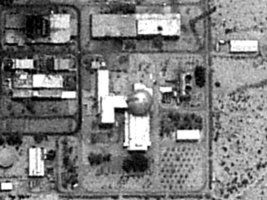 |
| Vol. 2 No. 8 | Table of Contents MEIB Main Page | 5 September 2000 |
New photographs of Israel's Dimona nuclear reactor published last month by the Federation of American Scientists (FAS) have confirmed that Israel has the capacity to have produced 100-200 nuclear warheads.
 |
| The Dimona reactor |
The high-resolution photos, taken in July by the Space Imaging Corporation's IKONOS satellite on behalf of the FAS, provide important clues as to the amount of plutonium and enriched uranium the reactor can produce, which in turn can be used to estimate the possible size of Israel's nuclear arsenal.
A comparison of the IKONOS photos with declassified American satellite photos from the 1960's indicates that there have been no additional cooling towers built at Dimona since 1971. According to FAS, this means that that the power capacity of the reactor has probably not increased significantly during this period. This contradicts previous reports, based on information leaked to the press by former Dimona technician Mordechai Vanunu in 1986, that the power level had increased to well over 150 megawatts.
The satellite imagery also indicates that Israel has probably not undertaken large-scale production of enriched uranium at Dimona. Although previous reports have alleged that the Israelis began projects to enrich uranium using gas centrifuge and laser separation techniques in the 1980's, the IKONOS photos reveal that newly-constructed facilities at the site are not large enough for industrial-scale uranium enrichment. According to FAS, "existing pilot-scale facilities [for uranium enrichment] would not appear to have the potential to substantially increase the total size of the Israeli nuclear weapons stockpile."
"Based on plausible upper and lower bounds of the operating practices at the reactor, Israel could have produced enough plutonium for at least 100 nuclear weapons, but probably not significantly more than 200 weapons," said the FAS report. Previous estimates had ranged as high as 400.
The satellite photos also indicate a large area of excavation, which the FAS said may hide an extensive underground reprocessing facility. Another area about half a mile from the reactor is believed to be a burial site for low-level radioactive waste.
The photos also revealed a nearby complex which had been built within the last fifteen years, possibly for defense-related purposes, such as deployment of the Arrow-2 anti-ballistic missile system. Iraq fired a handful of Scud missiles at the Dimona reactor during the 1991 Gulf War. Although the Scuds did not land in the vicinity of the reactor, the ongoing development of more accurate ballistic missiles by Iran and Syria is a serious concern. Although the site is defended by a battery of Hawk anti-aircraft missiles, they are not considered to be a reliable defense against this threat.
Israel has maintained a long-standing policy of ambiguity regarding its nuclear arsenal, frequently expressed in the statement that "Israel will not be the first to introduce nuclear weapons into the Middle East." However, the country has refused to allow international inspection of Dimona.
There is no solid evidence that Israel has ever conducted a nuclear test (although some have suggested that a large seismic event that occurred in the southern Indian Ocean in 1979 was the result of a joint South African-Israeli nuclear test).
� 2000 Middle East Intelligence Bulletin. All rights reserved.